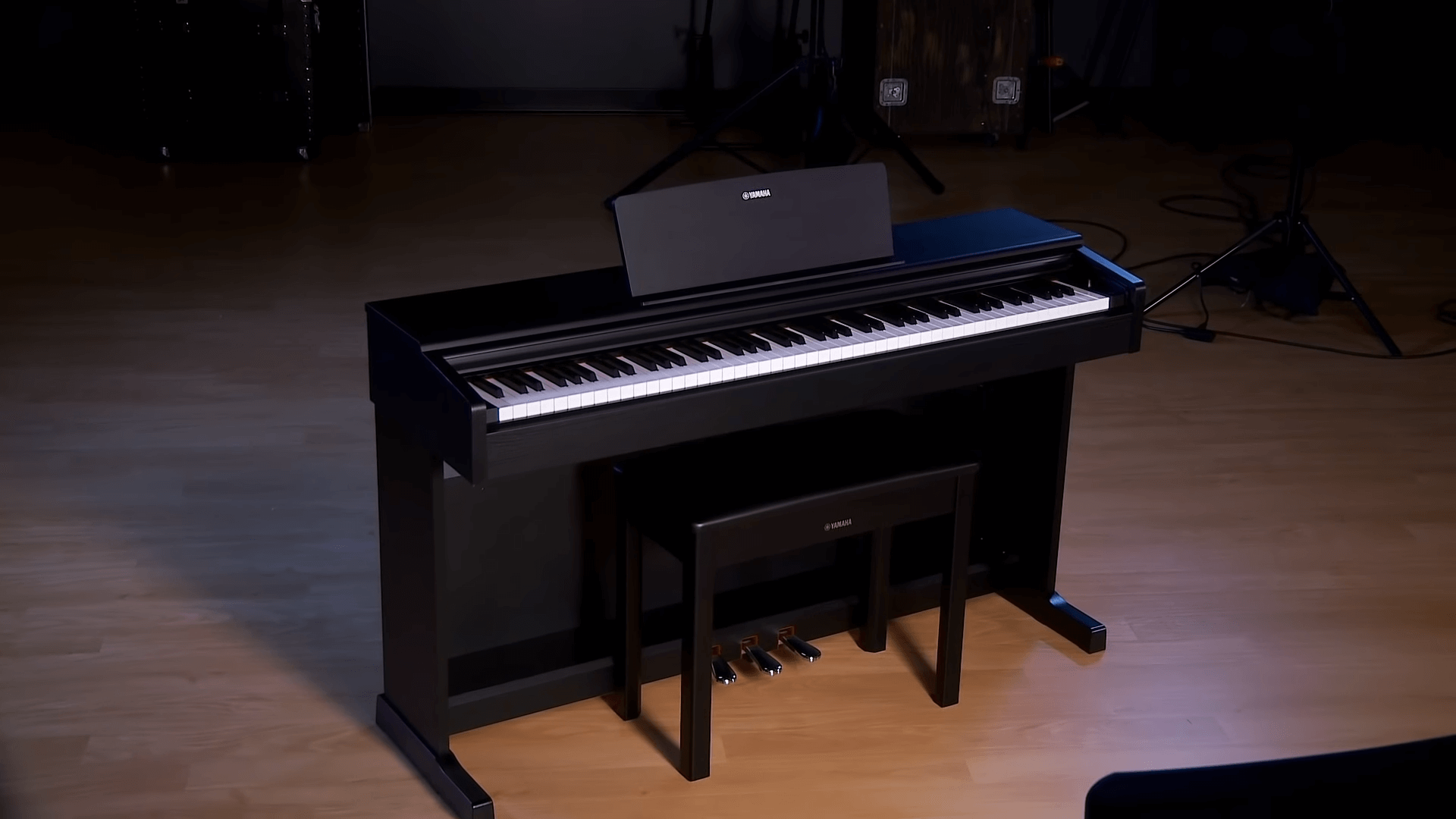
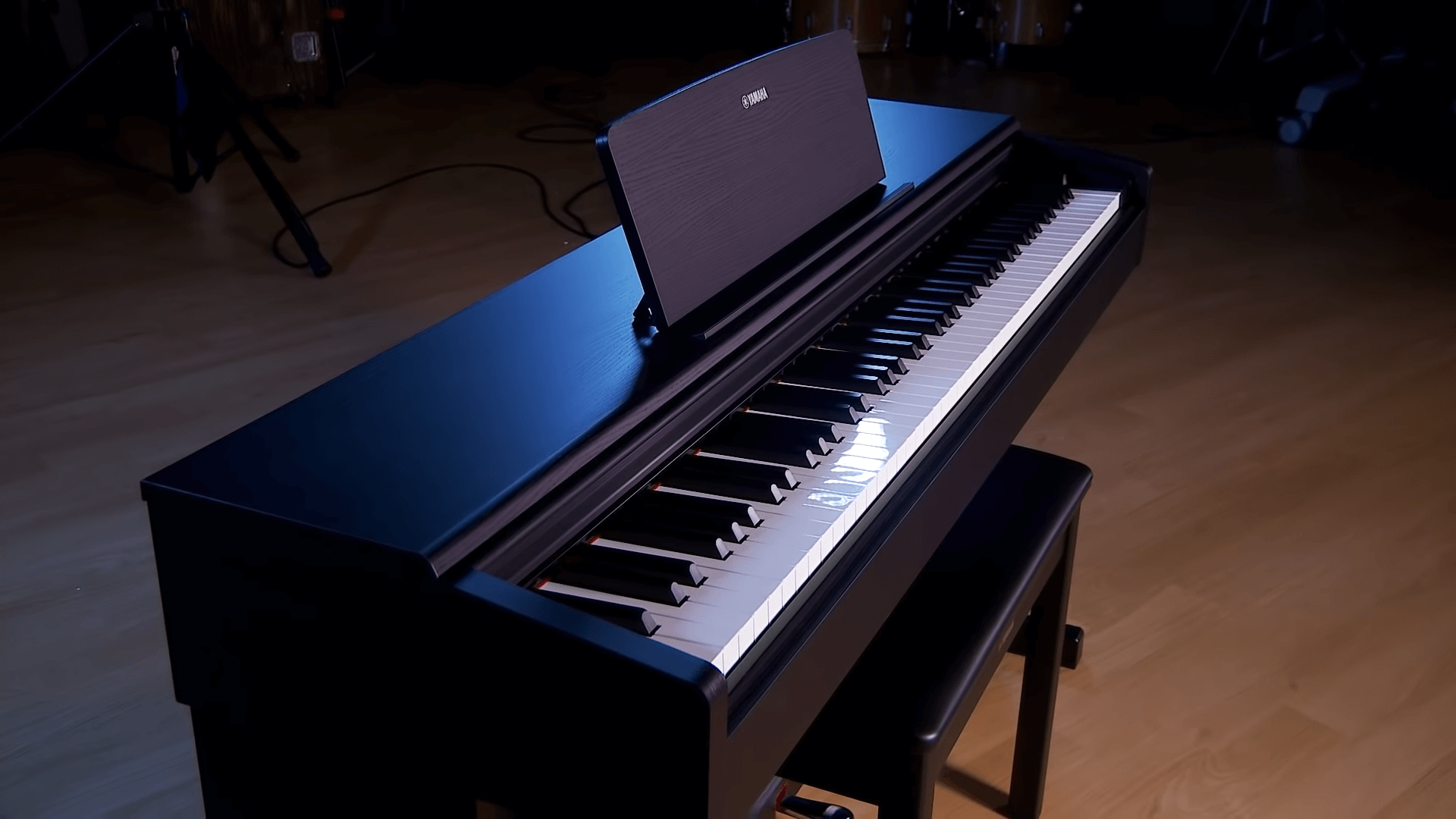
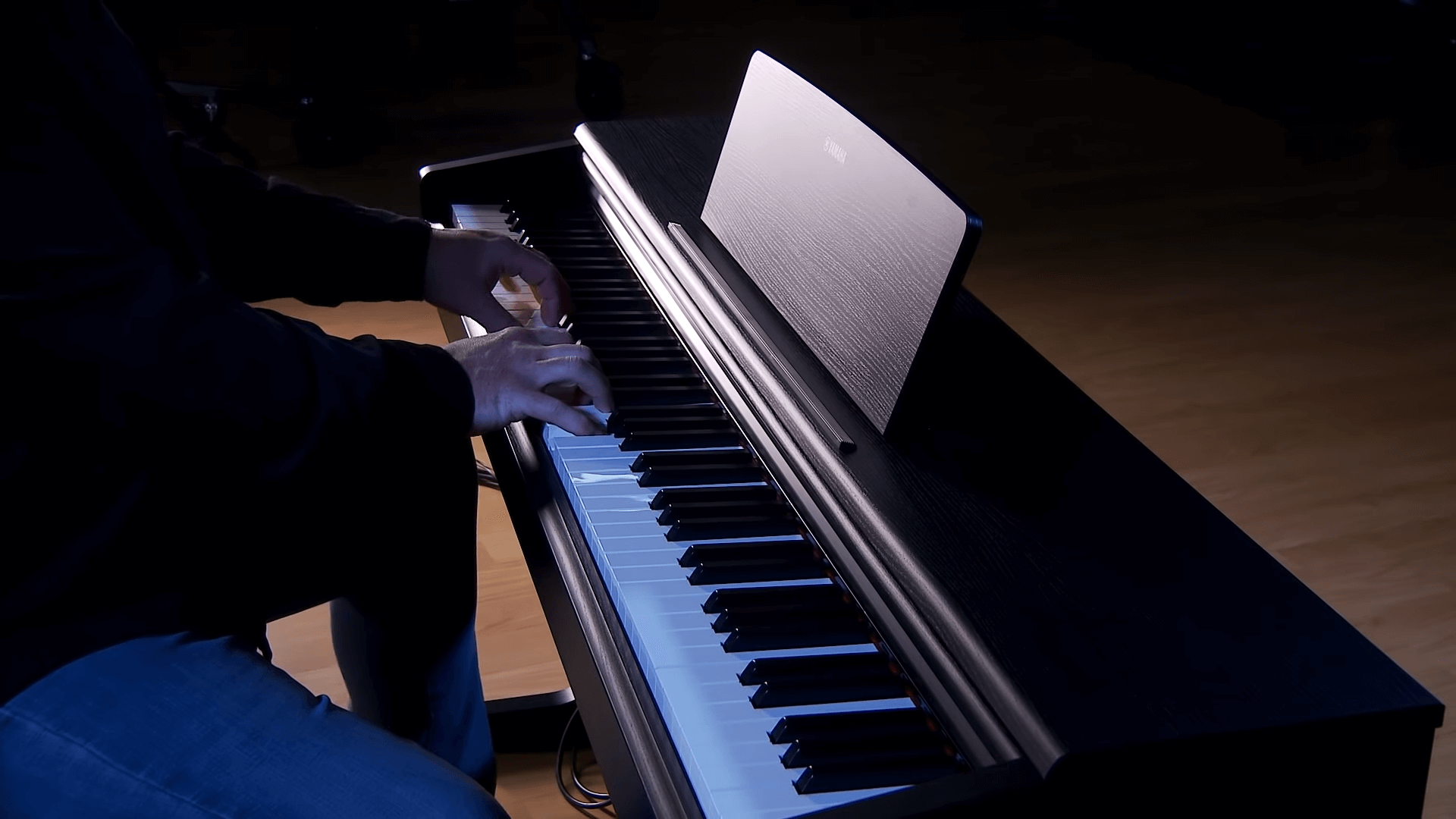
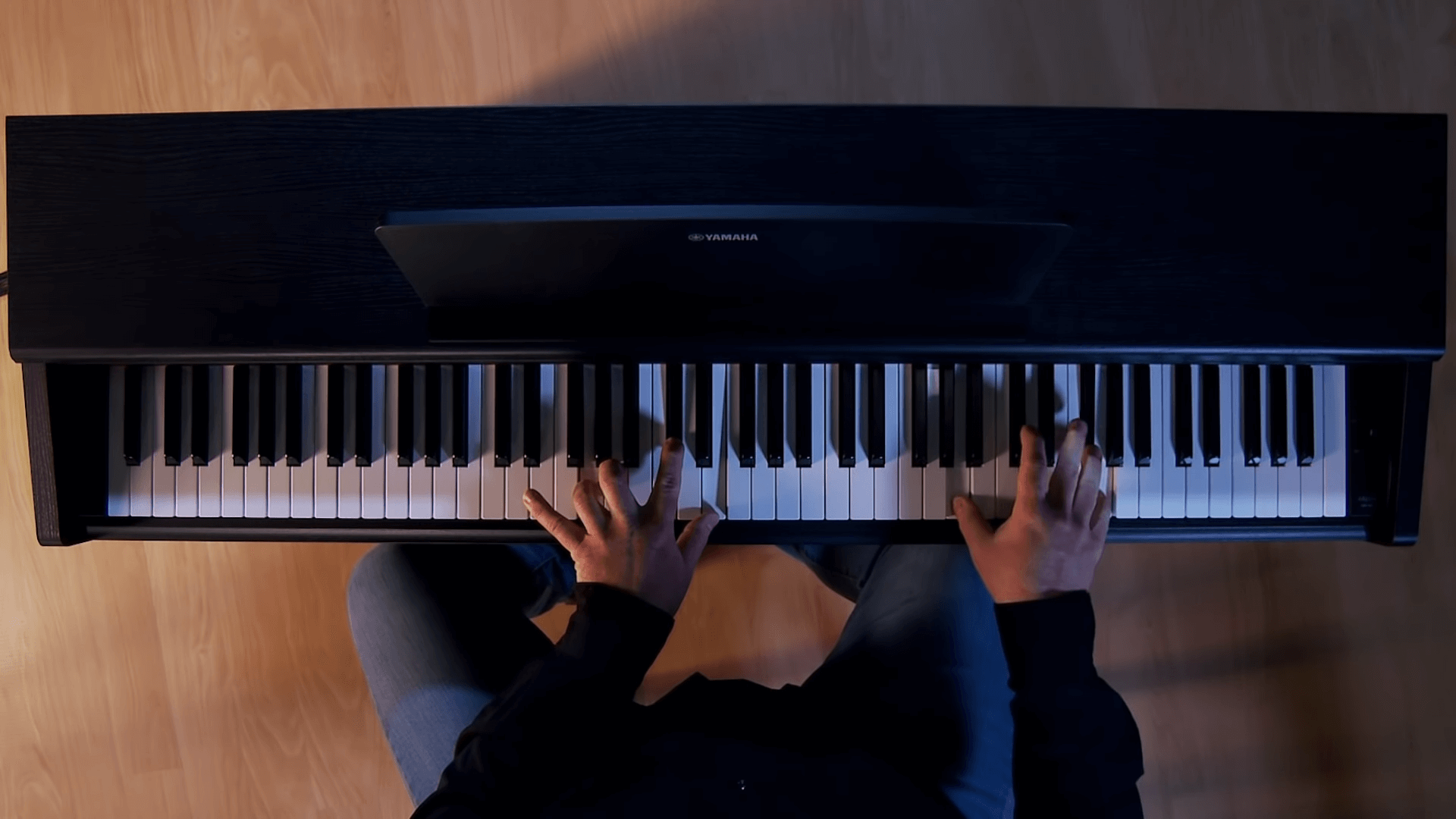
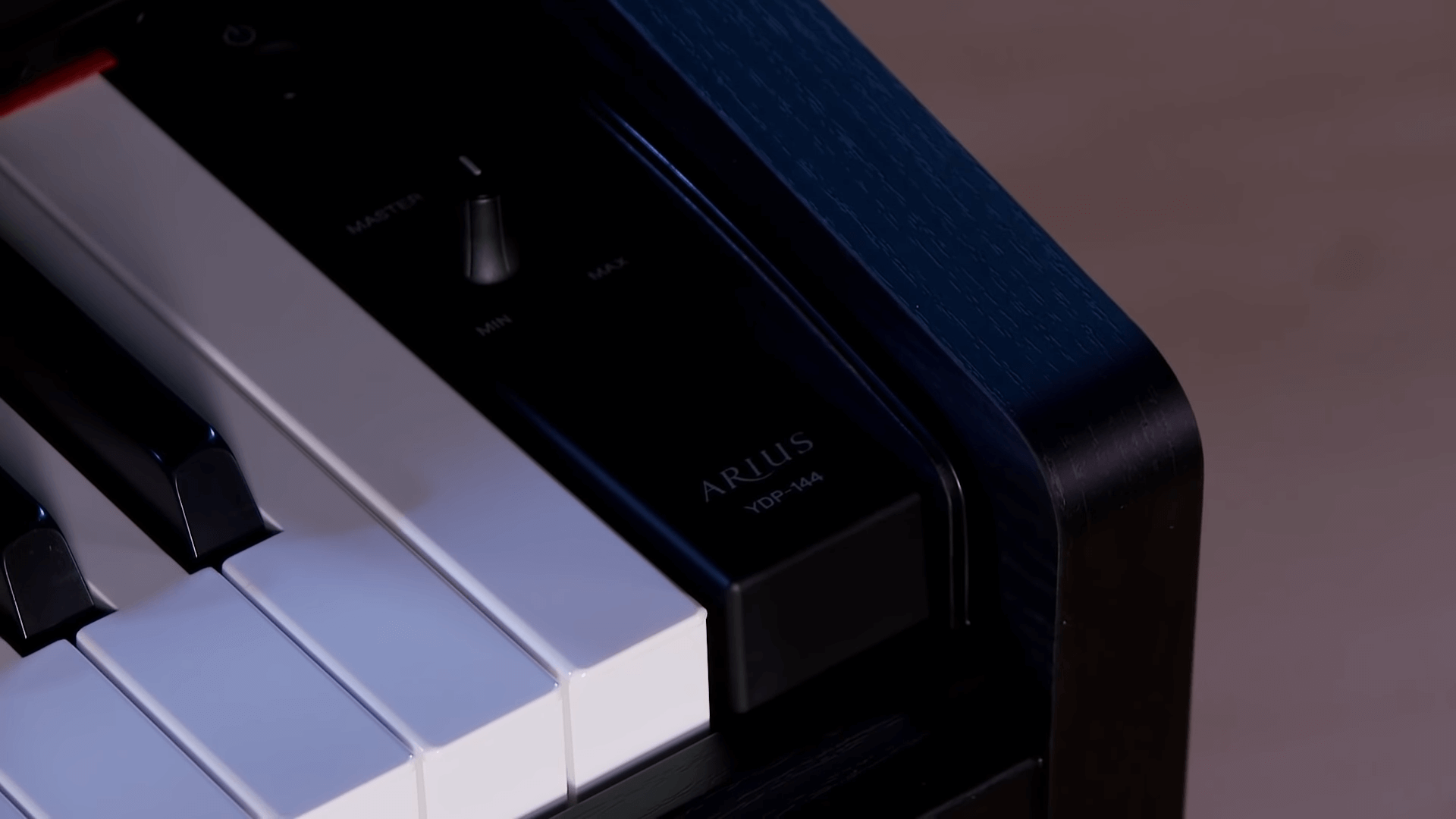
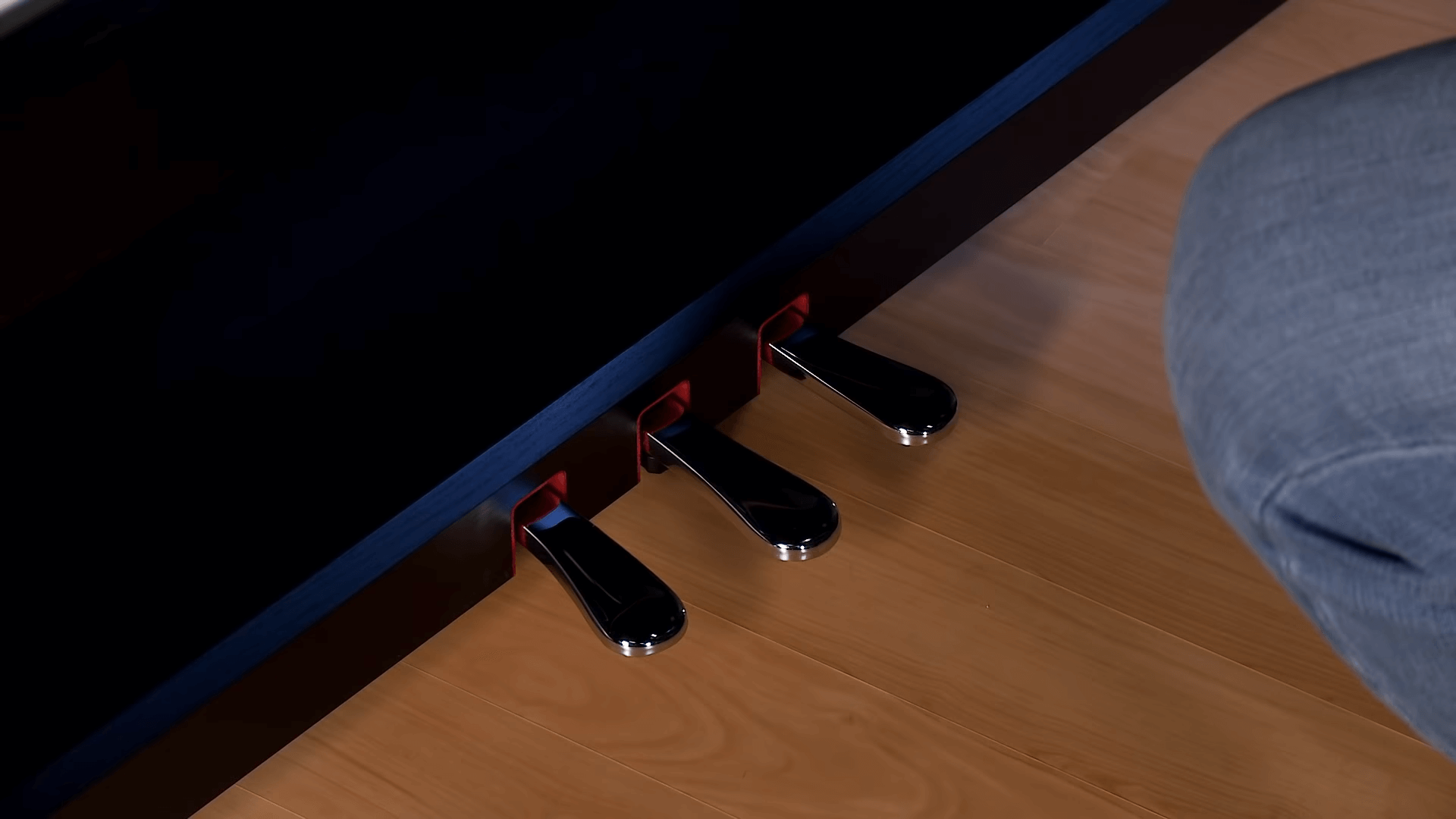
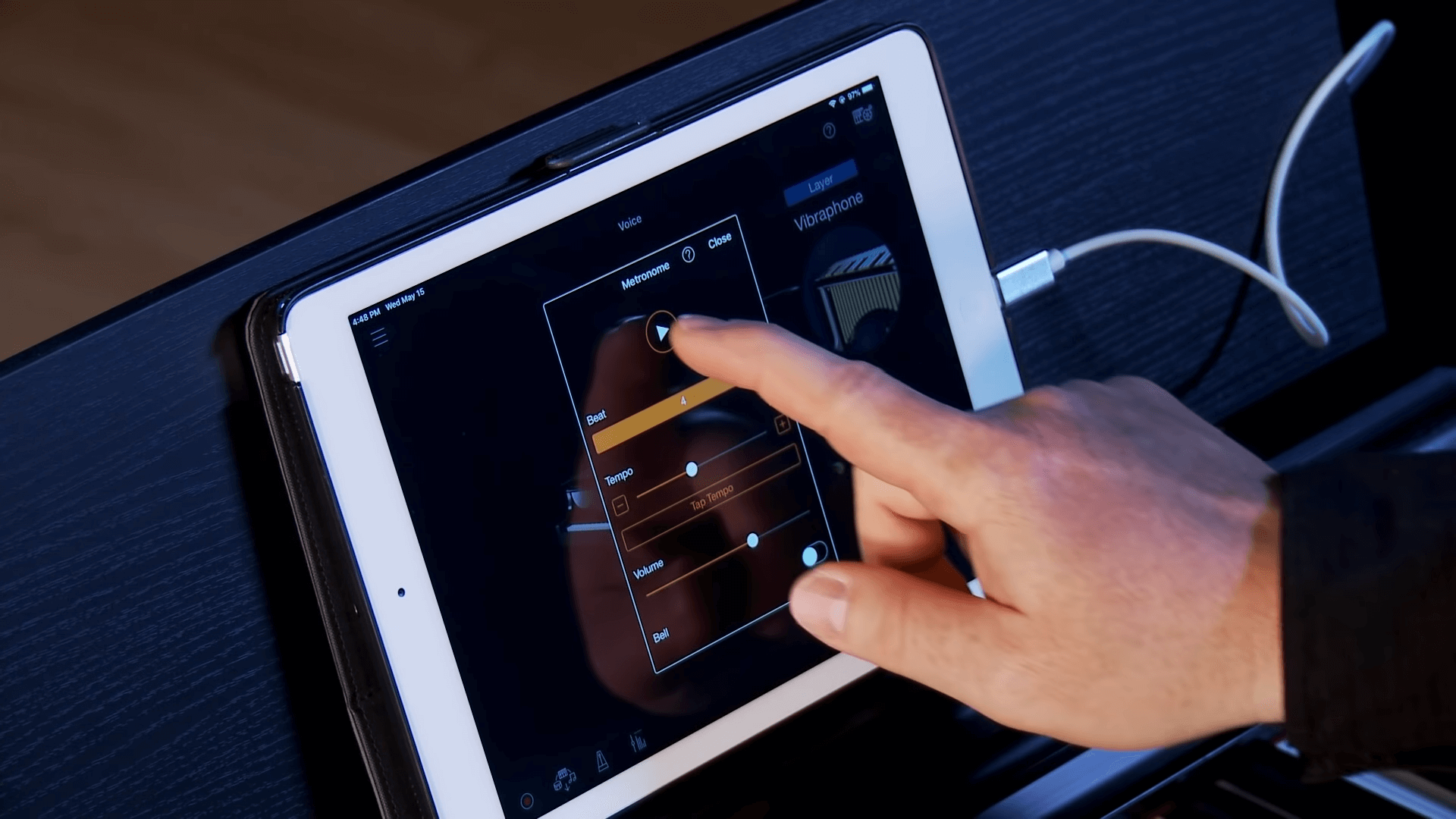







The YAMAHA YDP 144 was released in 2019 as an upgrade to the YDP 143. Being more modern, it should have a few more modern conveniences compared to previously-produced pianos from Yamaha and other manufacturers.
Also, despite being a beginner digital piano, the sound produced is modeled after Yamaha’s flagship CFX Premium Grand Piano, which makes it one of the best-sounding digital pianos in the market. These two factors, among other things, make the YAMAHA YDP 144 REVIEW below necessary for potential buyers who want to decide if the digital piano is worth their money or not.
| Dimensions | 53.4 x 32.08 x 16.6 in |
|---|---|
| Keys | 88 |
| Key type | GHS |
| Pedals | 3 |
| Presets | 10 demo songs, 50 classics |
| Polyphony | 192 |
| Tempo range | 5-280 |
| Tuning | 414.8-440.0-466.8 Hz |
| Internal memory | 900 kB |
| Power consumption | 9 W |
| Weight | 83 lbs |
| Warranty | 3-year limited |
As mentioned above, the YAMAHA YDP 144 is a 2019 model, making it fairly modern. While designed for the home, it can recreate the sound of the flagship Yamaha CFX Premium Grand Piano, which sounds so good that it was used by the winner of the International Piano Chopin Competition in 2010.
According to the Fryderyk Chopin Institute Trusted Source 18th International Fryderyk Chopin Piano Competition, 2021 The Chopin Competition is the most important musical event in Poland and one of the most important musical events in the world. Apart from its huge role in popularising Chopin’s music, it discovers the greatest pianistic talents, providing young musicians with the most effective start in their international career. It is a source of multicultural polarisation, which the world observes in various interpretations of the music of the brilliant composer. konkursy.nifc.pl , the Chopin Competition is regarded as one of the most important musical events globally. Some of the goals of the competition include discovering the best pianistic talents in the world and kickstarting their international playing careers. As such, a piano that recreates the sound of the Yamaha CFX Premium Grand Piano is quite impressive.
Nevertheless, the sound isn’t the only mark of quality in a digital piano. There are other features to consider and look for especially given the price point. Examples include the key design, controls, effects, connectivity, and more.
Given that this is a beginner device, some of these features aren’t very impressive. Nevertheless, there are some that make the purchase worthwhile. Consequently, we take a deeper look at these piano features in the sections below.
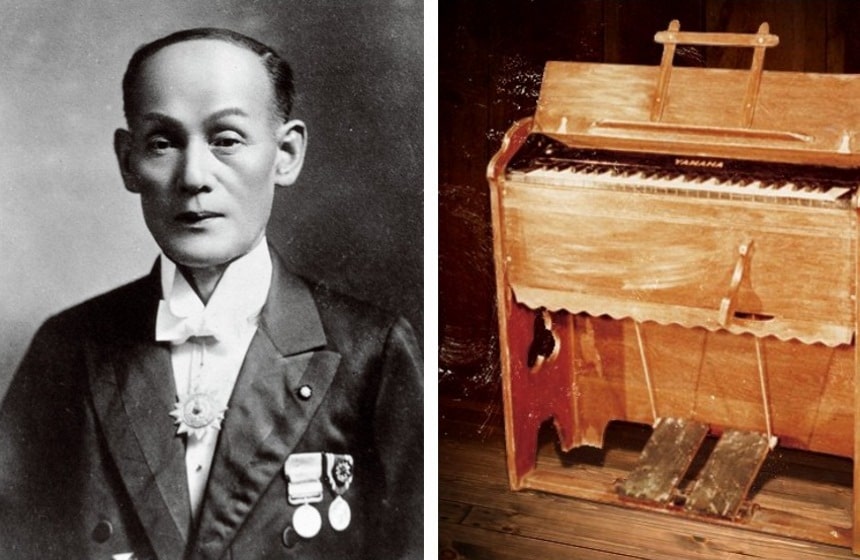
Yamaha has a long history of making keyboard musical instruments. In fact, the first project completed by founder Torakusu Yamaha was to build a reed organ in 1887. Over time, Yamaha has grown to become arguably the biggest manufacturer of musical instruments globally. In fact, according to the New York Times Trusted Source Business; Yamaha Is Mining Its Musical Strength AS Japan lapses into its fourth recession in 10 years, many big Japanese multinational corporations are confronting an even more dismal outlook than before. Not the Yamaha Corporation, the world’s largest maker of musical instruments. www.nytimes.com , at its peak in the 20th century, Yamaha could sell up to 238,000 acoustic pianos annually.
The company’s longevity implies Yamaha has a knack for producing high-quality products; otherwise, it wouldn’t have lasted this long. This is supported by the reviews for most of Yamaha’s musical instruments and the positive reputation in musical circles. Additionally, Yamaha is a prominent feature whenever you see a list of top musical instrument and piano manufacturers in the market.
Let’s not forget that some of Yamaha’s offerings, for instance, the Yamaha CFX Premium Grand Piano, have been used to great success in musical competitions such as the international Chopin competition.
Additionally, according to Reference for Business Trusted Source Yamaha Corporation - Company Profile, Information, Business Description, History, Background Information on Yamaha Corporation History of Yamaha Corporation www.referenceforbusiness.com , Yamaha has been a major producer of other audio products since the 1950s. The experience gained from producing these audio products has also been used to improve some of the musical instruments they have on offer, with the YAMAHA YDP 144 being a good example. Of course, this leads to better, more dependable sound reproduction and output.
Ultimately, it’s hard to argue against getting a Yamaha digital piano, given the manufacturer’s stellar reputation and their knack for producing some of the most reliable offerings in the market.
The YAMAHA YDP 144 incorporates a console piano design. Consequently, unlike acoustic pianos, there’s no soundboard at the back of the device. Additionally, it’s a full-size piano with 88 keys. Another design element is the music stand placed just above the keys.
Two stereo speakers are also included, and they’re positioned near the edges of the piano. They’re fairly small, and this is to be expected as the piano is only designed for home use. As for the finish, you either get it in dark rosewood or black, both of which are attractive if you can mix and match them to your home décor.
Also worth mentioning is the slim profile of the piano, which makes for a good fit in smaller practice rooms.
That said, something conspicuously missing from this digital piano is a display. Considering that you may have to use some combination keys to access some functions, this could be especially problematic. However, the device does connect and interface easily with most smart devices, including phones and tablets, that you can use in place of the screen.
Overall the design is simple and elegant, with a few bells and whistles included.
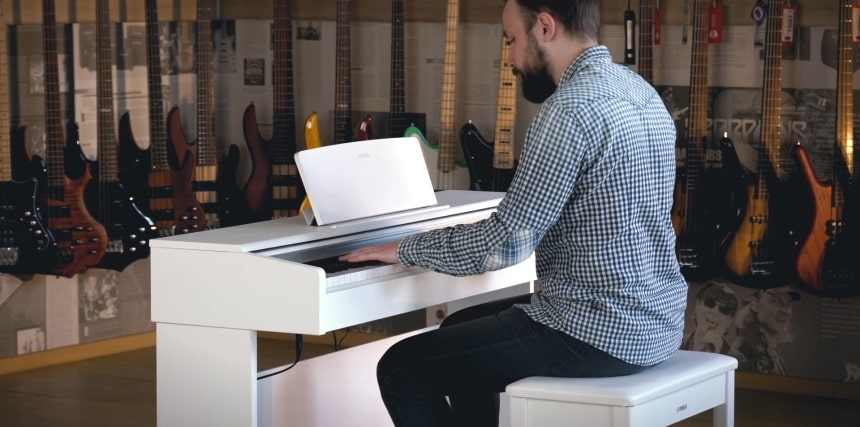
As for who can use it, the whole line-up of YDP or Arius piano models is designed for beginners, although some are more capable than others. One of the key features that makes it ideal for newbies is the intelligent acoustic control which offers automatic sound adjustments. Consequently, users can experience balanced sound without having to make manual adjustments.
Additionally, there’s the 88-key setup that should help beginners get used to a full-size keyboard early on. Another element is the 192-note polyphony that offers newbies ample room for growth, so they might not need to upgrade as soon as they get used to the instrument.
That said, the YDP 144 also has some features that make it an attractive purchase for intermediate players. One example is the Virtual Resonance Modeling (VRM), which has been used to recreate the sound resonance of the various components of an acoustic piano, e.g., the soundboard, frame, and rim. This effect is replicated even when wearing headphones.
Speaking of headphones, the YAMAHA YDP 144 is ideal for home practice sessions as it comes with two headphone jacks that allow for silent playback. That way, users can play the piano, play duets, and take lessons without making noise for others in the household.
Also, while it may not be suited for playing in concert-style venues like churches, it sounds terrific since it can effectively recreate the tone of the Yamaha CFX Premium Grand Piano. This makes for an enjoyable playing experience, whether you’re a beginner or an intermediate pianist.
The YAMAHA YDP 144 consists mainly of particleboard construction in black and rosewood finishes. If well-taken care of, there should be no worries about the longevity of the piano. Additionally, the finishes are fingerprint-proof which helps maintain the aesthetics.
Another construction element is the matte black key tops that feel well-made during use. Furthermore, the keytops absorb moisture, all while remaining tactile and usable. As such, you have nothing to worry about if your fingers get sweaty as you play. These keys, in addition to the white ones, are made of synthetic ebony and ivory.
Also worth mentioning is the inclusion of responsive buttons on the edges of the keyboard. However, they are fairly limited in function and number, which means you may have to use a few key and button combinations. Ultimately, this can complicate use.
In terms of dimensions, the YDP 144 measures 53.4 x 32.08 x 16.6 in. The general size is to be expected, given that there are 88 full-size keys included. However, as mentioned above, it has a slim profile, which makes for an easier fit in smaller practice rooms.
Also, the Yamaha YDP 144 weighs 83 lbs. While this is a bit heavy, it’s still movable if necessary, especially if you have an extra pair of hands. However, the design seems to be most suited for stationary use.
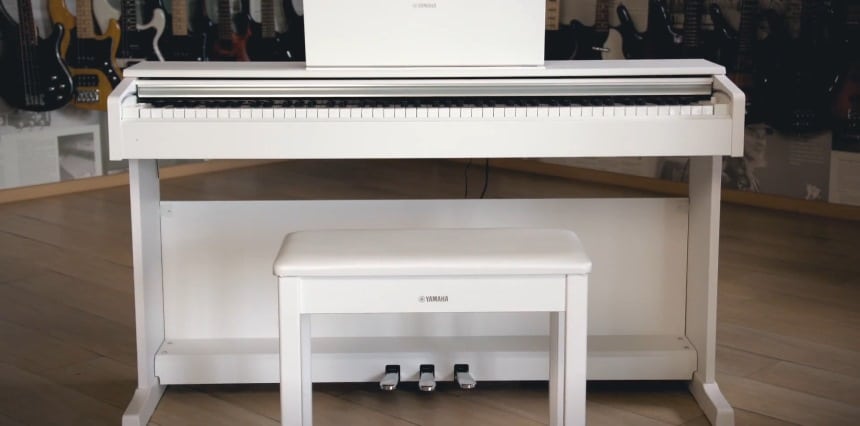
The Yamaha YDP 144 ships in a box with several components included, i.e., the piano section, power supply, pedal unit, back panel, and legs. Furthermore, even the bench provided comes in several pieces, so some assembly will be necessary. However, the instructions for assembly included in the manual are easy to follow.
It’s a two-person job since you’ll have to lift the long and heavy piano section onto the stand, and you risk damaging the device if you try to do it alone. Other than that, the assembly is pretty straightforward, with the only tools needed being a Phillips head screwdriver and maybe a box cutter. Also, it should take less than ten minutes if you’re proficient with the screwdriver.
The warranty provided by Yamaha is the same one they offer for their DGX600, CP, and P series, which extends up to three years after purchase. It covers both repairs and replacements, although there are no guarantees that the replacement you get will be brand new. You could get a working reconditioned piano instead.
Nevertheless, if you claim the warranty, you will be responsible for some of the logistical overheads such as removal from your premises, shipping charges, and re-installation. The three-year coverage should be enough to determine the quality of the piano, especially if it gets regular use.
The controls seem like a mixed bag of the good and the bad. There are buttons included on the edges of the piano section for changing settings such as volume, voice, metronome, and more. They seem responsive, and you can feel them click into place whenever you press them. Furthermore, there is usually an audio confirmation of changed settings from the piano’s speakers.
Nevertheless, the buttons are fairly limited in number and function. As such, you’ll need to access some of the settings and functions of the piano using key combinations. This can be pretty frustrating as the only way to ensure you changed the correct settings is to check the sound by playing the keys.
If you’re a newbie to playing the piano or musical instruments, using the keys to check the sound may not be feasible, especially if you can’t differentiate between the various sounds just yet.
Thankfully, the piano supports the USB connection of smart devices. From there, users can incorporate a digital controller or the Smart Pianist app to make it easier to change settings. However, there are a few smart devices that are incompatible with the machine.
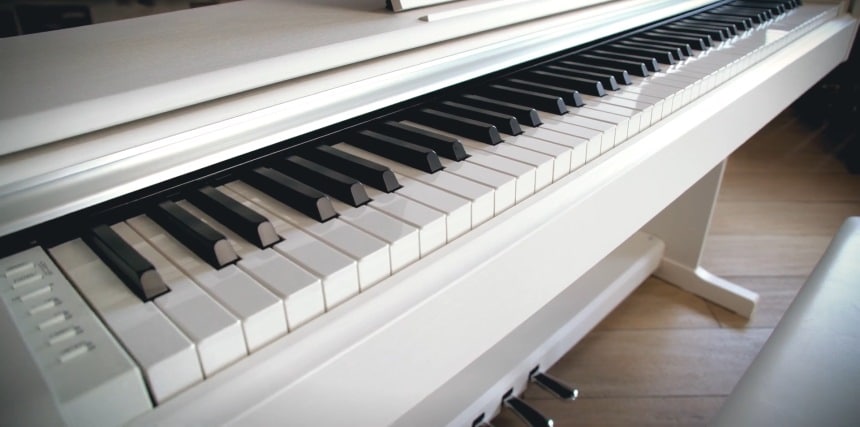
Yamaha goes with a full-size 88-key GHS-weighted action keyboard which is the action they choose for some of their lower-end pianos, including the YDP 144. For beginners and intermediate players moving from a synth-action keyboard or piano, the Yamaha YDP 144 will feel and play like an upgrade.
The GHS-weighted action feels heavier in the low keys and significantly lighter on the high ones. This is meant to mimic the feel of playing an acoustic piano where the lower keys move heavier hammers than the high keys during play.
Additionally, there are four settings for the touch sensitivity of the piano, including soft, medium, hard, and off. The default is the medium, and if you feel it doesn’t work, you can switch to any of the other three.
Nevertheless, if you’re used to playing acoustic pianos or have played higher-end digital pianos, the keyboard may be a little disappointing. While it does feel good while you’re pressing down the keys, there is a springiness that feels unnatural when you let go.
A display is non-existent on the Yamaha YDP 144, which, as mentioned above, makes it tricky to change the settings. However, there is the option of connecting your smartphone or tablet via USB. Once you’ve installed a digital controller app, accessing some of the controls and settings will be a lot easier. However, there seem to be some connectivity issues for users using version 15 of the iPad and iPhone operating systems.
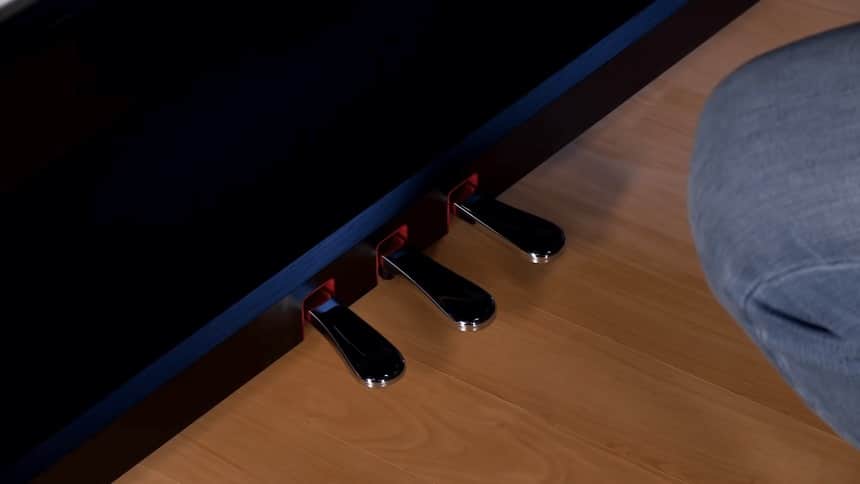
This console piano also incorporates a three-pedal setup in its construction, including soft, sostenuto, and damper pedals. These pedals feel great to use and are sufficiently responsive. Furthermore, the damper pedal supports half-pedaling, allowing extra functionality and a more realistic playing experience.
As for the included effects, the Yamaha YDP 144 isn’t the most impressive option out there. It keeps things simple, which might not be a problem for beginners. However, as they progress in skill level, they will need to experiment with more and more effects. In that case, the YDP 144 can be quite limiting. That said, there are still some elements to look forward to, as shown below.
Polyphony is the simultaneous combination of multiple tones or melodic lines. As such, the polyphony of a piano determines how many melodic lines you can combine in a song you’re playing.
For a beginner or newbie device, 64 notes of polyphony are the minimum you should go for, although a few piano and keyboard models offer less than that. That said, ideally, you should get a piano with 128 notes of polyphony or more, as that gives you more room for growth when you start stringing melodies together.
The Yamaha YDP 144, on the other hand, is an impressive device thanks to the 192-note polyphony. While not the class-leading 256 polyphony available in the YDP 184, you’ll struggle to string along more than 192 notes even as an advanced player. Consequently, the 192-note polyphony should prove sufficient for a long time to come.
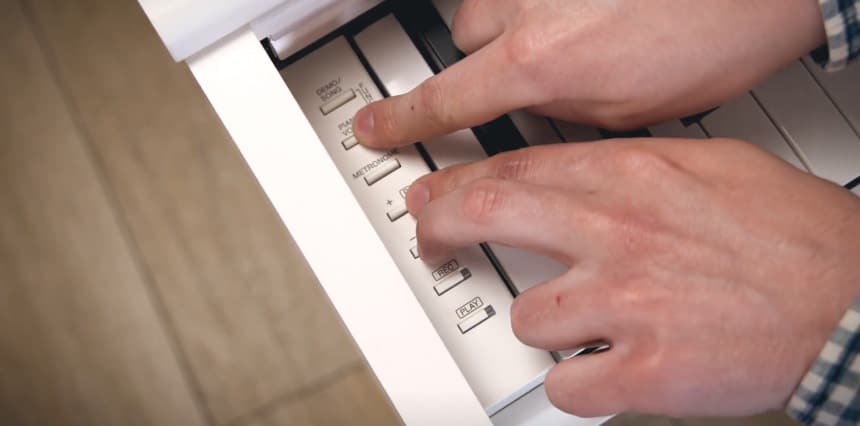
The Yamaha YDP 144 has ten voices, some of which have been sampled and imported from top-of-the-line acoustic and electric instruments. The CFX concert grand is one of them, and there are three variations sampled and included, i.e., Normal, mellow, and pop. Additionally, there are voices from the DX7-style FM synthesizer and Fender Rhodes, both of which are electric pianos on Yamaha’s line-up.
The rest include an orchestral string ensemble, vibraphone, harpsichord, and two organs. Despite being sample-based rather than using piano-modeling technology, all of these voices sound great, especially in the case of the CFX concert grand, which is a key selling point for the YDP 144.
Notably, there are only four effects available with the YDP 144, with the main ones being damping resonance and reverb. With the latter, you get four types of reverb, including chamber reverb, club reverb, concert hall, and recital hall.
Additionally, there are some unique effect types, i.e., the stereophonic optimizer and the intelligent acoustic control. The IAT is integral for ensuring balanced sound at different volume levels.
As for the stereophonic optimizer, it allows users to enjoy the feeling and sound of playing an acoustic piano even when they’re wearing headphones. This is in part thanks to the Virtual Resonance Modelling used by the manufacturer to recreate the resonance of various components of an acoustic piano, e.g., the soundboard, rim, and more.
Notably, while these effects are sufficient, especially for beginners, there are still a few missing, including options like chorus, brilliance, and more that can be found in some higher-end models.
Loaded onto the instrument are ten voice demo songs that can give you a better idea of how the voices on the piano sound during playback. Furthermore, there are an additional 50 classic piano tunes that you can listen to and practice playing as well.
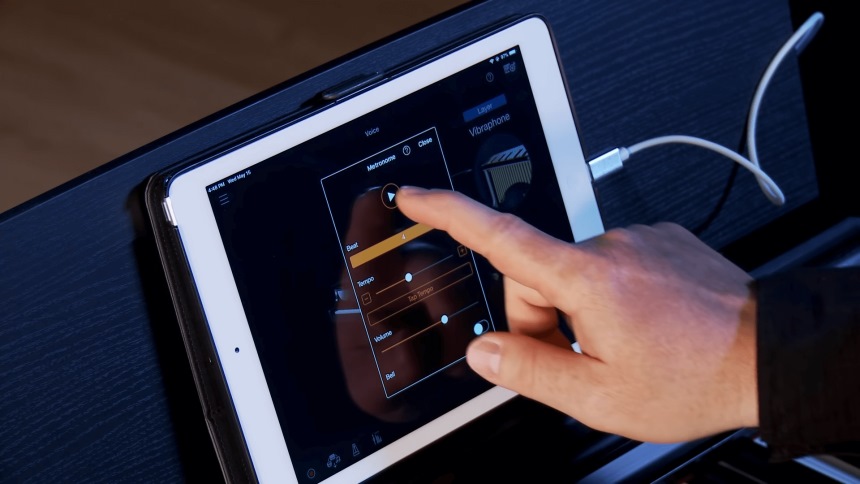
In terms of connectivity, there are a couple of things to note concerning the YDP 144. The lack of outputs and inputs, for instance, severely limits the machine’s capabilities. Additionally, there is no MIDI input or output. This means that you can’t pair a MIDI controller with the piano to access specific MIDI effects like attack, legato, vibrato, and more.
Additionally, there’s no aux in or out. However, USB connectivity does help make up for the missing screen on the piano. Once users have connected their smartphones or tablets to the piano and downloaded the Smart Pianist app by Yamaha Corporation, they should be good to go.
That said, there is a connectivity problem whenever you try to use iPhones or iPads using version 15 of their respective operating systems. Other than that, most smartphones and tablets connect pretty quickly.
Other elements of the connectivity that are worth noting are:
All piano models in the Yamaha YDP or Arius line-up, including the Yamaha YDP 144, come standard with two headphone jacks. If you use high-quality headphones, they should give you an impressive sound experience due to the piano’s superb sound and the stereophonic optimizer. This means they can have completely silent practice and training sessions for users.
As for storage space, you get enough to store about ten songs but no more, which is pretty disappointing. Additionally, there is no provision for external drives to be incorporated, further limiting the device’s capabilities. Nevertheless, if you’re just using the piano for practice sessions and training, which is what it’s meant for, the storage space shouldn’t be too much of a problem.
The Yamaha YDP 144 ships with a power adapter to be plugged in during use. As such, you may want to position it as close to a socket as possible.
In terms of the accessories, one of the major inclusions is the playing bench that just needs a bit of assembly before it can be used. Another inclusion is a music book with up to 50 classical music songs that may come in handy as you’re learning to play. For users who need extra accessories such as high-quality headphones and more, they will have to go back into their pockets.
As for the price, you can get the Yamaha YDP 144 for $1000-$1500, which is the general price range for other competitors in its class as well. Examples include the KAWAI KDP110, CASIO PX-870, and the ROLAND F-140R. That said, we feel there is sufficient value in the machine to justify the price range, although there could still be some improvements.
| PROS | CONS |
|
|
With this Yamaha YDP 144 review, you can see there’s value for money in the purchase, especially for beginners and newbies who have decided to take a serious interest in playing the piano. The device is well-suited for the home in terms of the construction and the silent playing capabilities provided. Furthermore, the polyphony provided allows enough room for growth and may even work for some advanced players.